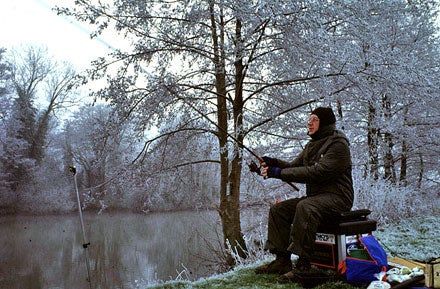SUCCESS WITH THE FEEDER – DAYTIME FISHING
|
|
A couple of months ago I wrote a little piece about night fishing for bream on the feeder. Well, to back it up, with a little more helpful information perhaps, and since one or two newcomers to FM have asked about feeder fishing in general recently, this is my ‘daytime feeder’ piece.
First of all, let’s talk about the types of feeder. Basically two types, the closed cap or blook-end feeder, sometimes also called a maggot feeder, and the open-ended feeder often referred to as the groundbait feeder. The method I would resort to if challenged with fishing a river is the open-ended or groundbait feeder. The best ones, I have always found, are the Drennan green ones (I wrote a piece sometime ago about modifying the links on them).
Now we’ve sorted the feeder, there’s the way to tie it on. Personally (and I’ll take the same flack all over again), I favour the closed loop method, but only with mainlines up to 4lbs and hooklengths no stronger than 21/2 lbs. If you don’t want to use it, fair enough, try another method. Hooks should be 16 to begin with, moving up to 14 if bites are confident from bigger fish or moving down to 18 or even 20 if the fish are shy. My previous best Thames Chub (5lbs 7ozs) came in on a 20s hook tied to 1.7lb Drennan Double Strength hooklink and a single caster, by the way!
OK, that’s the feeder and the hook/length sorted. Before we go any further let’s talk positioning.
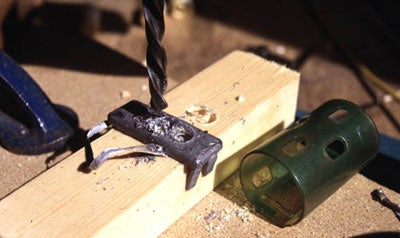  Drilling the feeder weight |
Position yourself so that your rod is pointing downstream and angled ever so slightly towards the river. The height at which the tip stands will depend very much on the flow of the river. A strong flow and you want that rod as high as you can get it. Hardly any flow and the tip may well be touching the water, but there is slightly more to it than that.
Being Critically Balanced
The weight of the feeder and how much line you can have in the water all add to the equation, and I’m afraid that you need a few fishing trips to the same spot in different conditions to gain the experience to judge this. For example, a very fast flow and you’ll need the heaviest feeder you can buy with added ‘dead cows’ (extra weights clipped on) and the rod as high as possible (with you having to stand on your seat box if necessary). On other occasions the flow may be so weak you need to lighten the lightest feeder by removing the weights and drilling holes in them to remove more weight.
How to judge when it’s right? Look at your river and decide your furthest cast. Tie on a feeder of the weight you think is required and cast it. Don’t click the bale arm on yet! Let a few coils of line out first to develop a nice bow in the line (see diagram below). Now click the bale over and place the rod in the rests. Watch the tip, it goes around in a bend then straightens as the feeder loses grip on the bottom.
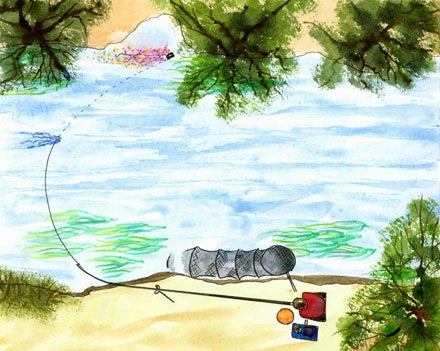  Overview of feeder fishing position (click for bigger picture) |
Basically, this should happen once and once only. If it doesn’t happen at all, the feeder is too heavy or not picking up enough current. If it happens two or three times, it’s too light and you need to heighten the rod or add more weight to the feeder. When the rod straightens up just the once, the rig is ‘critically balanced’. How many times have you heard that, but here it means that if a fish bites, it’s going to pull the feeder off it’s hold and the rod will straighten again.
That’s a drop-back bite and you strike it. The quivertip of the feeder rod should always have a gentle bend in it so that you can always spot these drop-back bites. If you get a drop-back as soon as the feeder hits the bottom you may think it’s the feeder settling. Well that again is down to experience and you may miss a few quick bites at first, not knowing the difference.
What To Put In The Feeder?
Standard practice with the A4 team was to start with a mix of: 1 pint caster, 1 pint of boiled and drained hempseed (save the hemp water), and a tiny amount of breadcrumb. About 1/2 a cupful of breadcrumb at most. It’s amazing how far it goes and it’s really just to bind the caster and hemp together to get it out to your swim in the feeder. Wet the mixture until it’s damp with the drained hemp water and that’s all, it’s not to feed the fish at all.
This mix, together with say two red maggots on the hook, will attract all the usual silver fish plus big bream and chub. If chub come on the feed swap the hookbait to caster and maybe move down to 18s hook size. If bream come on the feed you might want to mix up some cereal groundbait, say Sensas 3000 Bream (red or white) 50/50 with a brown crumb. Mix it nice and light, add the water (perhaps any leftover hemp water) to the groundbait, never add groundbait to water or you end up with slop, and leave it for ten minutes. Add a little more water if necessary, it should be friable when you run it through your fingers, yet it should hold together gently when you squeeze it.
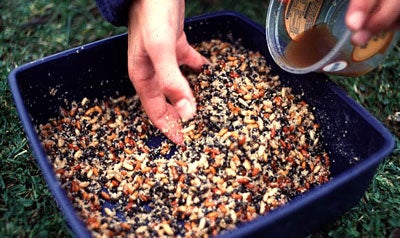  Hemp and caster mix |
You might also want to move to a size 14 hook and three red maggots if bream take over. Red worms are also a bream favourite as is sweetcorn and don’t forget to try a cocktail mixture.
A useful device for spotting gentle bites, if bream are about, is a target board. I have stuck different coloured strips of electrical tape on mine. It makes it so much easier to see the gentlest of movements in daylight. However to use one your rod may have to be closer to the ground. If it’s well up in the air I have known times when I have sighted the tip against a twig on a nearby tree. Any movement away from that and I have hit it, but it strains the neck after a while.
Where And When To Put Out The Feeder?
This method can be used on medium to big rivers so we’re talking more or less 20 yards to 80 yards casting. Choose a far bank marker, a bay or a bush, or a stump.
On a narrower river you may only get a choice of two distances, whereas on wider rivers you can select three distances. Lets say a 20 yards, 40 yards, and a 65 yards cast. The feeder weight has to be based on the furthest chuck so the setup may not be as sensitive on the shorter casts, that’s something you have to put up with, but at least your feeder shouldn’t go trundling off downstream every cast.
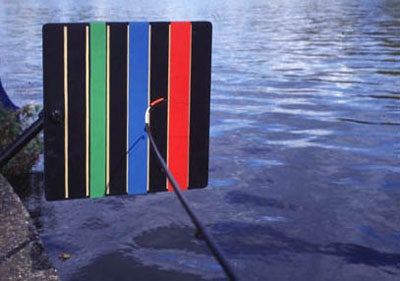  Daylight target board with coloured strips of electrical tape |
When you start fishing, cast to the 20 yard mark. Count to 50, in seconds, reel in, fill the feeder, cast again. This time count 100, again in seconds, reel in, fill the feeder and cast again. This time count 150 before reeling in, that’s if you haven’t had any bites, but don’t worry, you’re building up the bait in the swims.
Now with this next feeder full, cast to the 40 yards mark. Again count 50, then refill, recast and count 100, etc. After three casts there, cast to the furthest mark at 65 yards. Again, another three casts of 50, 100 and 150. Back to the first mark to repeat the exercise and all the time you are building up the feed in each swim.
If one mark starts to produce fish, see what they are and judge whether you think there might be better quality fish further out or further in. You might be catching bleak for example and not want to bother with them, so you concentrate on casting away from that swim. Don’t leave it out completely as bigger fish may later move in having seen the bleak feeding avariciously.
Don’t forget to try a change of bait if after a couple of repeats you haven’t caught anything. Change to a redworm, or caster or even white maggot, but don’t stop feeding and don’t leave the feeder sitting out there, the old ‘chuck it and chance it’ method. That will catch you nothing!
There is no such thing as too cold for this method. Well, perhaps there are limits as the picture at the top shows. That was Christmas Eve (a custom of mine) ten years ago and I blanked, but who could blame the fish. Would you want to play in weather like this?
| JEFF WOODHOUSE |
|
Jeff caught his first fish at the age of five, a mackerel from a Torquay fishing boat. That was the starting point 53 years ago and the sight of that living silvery image coming up from the invisible depths had him hooked for life. Since then he has practised virtually every type of fishing, although not always successfully. He doesn’t just like fish, he has a love affair with them, in his living room, in his garden and at times, in his freezer. Lately he has spent more time either running clubs or assisting them to become successful. Now he admits to being too old to chase monsters, he’s happier getting as much fun as possible out of what’s before him. In this monthly series Jeff indulges the rebel within himself, often controversial and always trying to think differently about the usual trends in fishing. |










